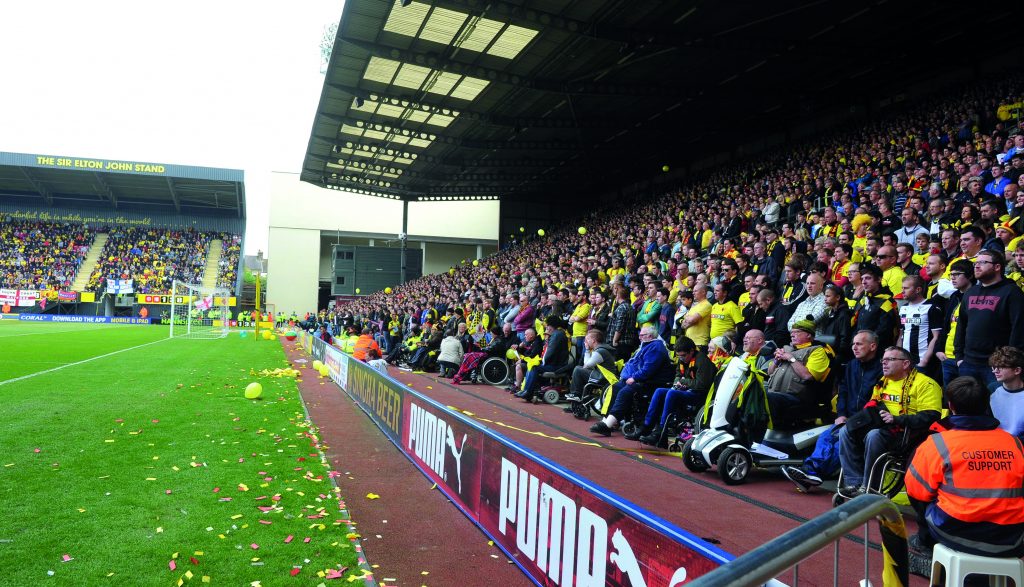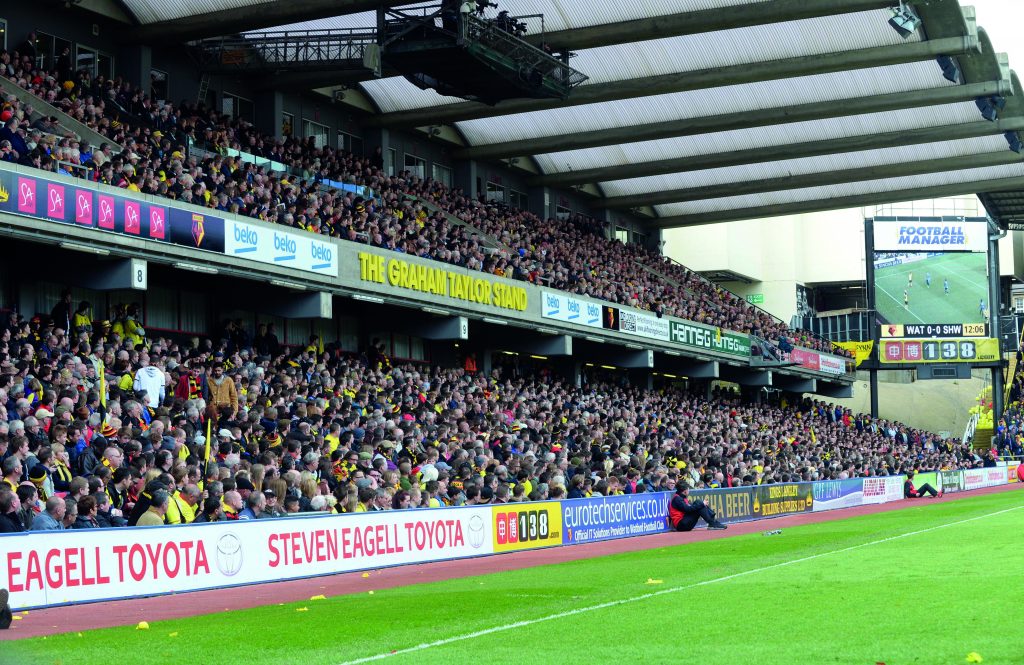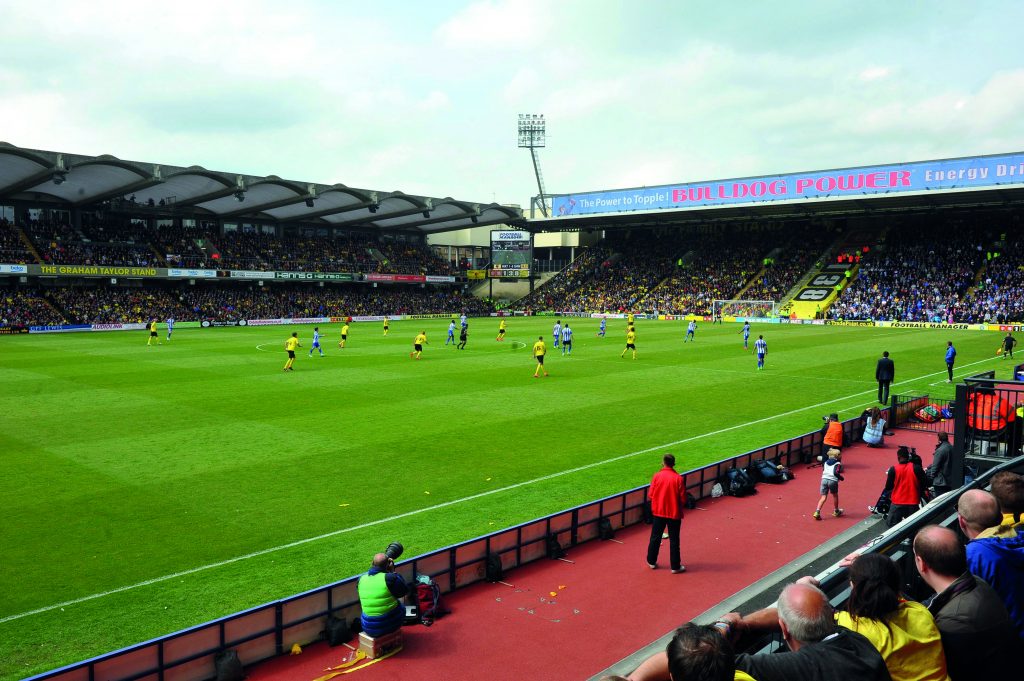Travel guide for Watford and the Vicarage Road Stadium
Below you will find your perfect guide for going to England to watch Watford at Vicarage Road Stadium!
Headlines from the travel guide:

WATFORD RECORD
FA Cup runners-up: 2 (1984, 2019)
First Division runners-up: 1 (1983)
Championship play-off winners: 2 (last 2006)
UEFA Cup Round of 16: 1 (1983)
VICARAGE ROAD STADIUM
Pitch: 105 x 68m
Opening match: August 30, 1922 (Watford – Millwall 0-0)
Vicarage Road Stadium
Vicarage Road
Watford
WD18 0ER
VICARAGE ROAD HISTORY
Vicarage Road was built in 1922. The stadium is very characteristic where the stands are slightly different, and have evolved in different ways throughout history.
The sides and ends have their own history. New stands were built when there were financial resources to do so.
For example, the newest section, The Rookery Stand behind one goal, was largely funded through the sales of Paul Furlong and Bruce Dyer in the nineties.
Another investment was floodlights. They were installed until 1953, on the roof of the Main Stand. Since then, they first moved to four pillars in the corners but are now found on the roofs of the stands at each end.
Groundsharing
From 1997/98 to 2012, Watford shared Vicarage Road with rugby team Saracens. It solved the rugby club’s stadium problems and gave Watford additional revenues.
In 2003, Watford were forced to sell the stadium to solve their economic problems.
Through the campaign “Let’s Buy Back the Vic” the club managed, however, to collect enough money to buy back their ground. Of course, Elton John was one of the contributors. He gave the campaign proceeds from a concert he staged at Vicarage Road.
The problems were not over. In 2004 they were forced to shut down parts of the Main Stand due to safely reasons.
New Elton John Stand
In 2008 the Main Stand was completely closed, and in 2014 a new stand was finally built in its place and named the Sir Elton John Stand. The stand opposite was renamed the Graham Taylor Stand, so the club’s two most famous faces were honoured.
Now home supporters are in The Rookery stand while the away supporters are housed in The Vicarage Road stand on the level above the short side.

WATFORD DIRECTIONS
Train:
From London Euston take a local train to Watford High Street station, from there it is a ten minute walk to the stadium.
There are faster, and more frequent, services from London Euston to Watford Junction Station. From there it is a 30 minute walk (or a short taxi ride) to the stadium.
Underground:
Take the Metropolitan line to Watford, then a 30 minute walk to the stadium.
Information: www.tfl.gov.uk – Transport for London
WATFORD BARS
Watford is a very vibrant community and Vicarage Road stadium is walking distance from the town centre. This means that the range of eateries and pubs are wide from fine restaurants and pub chains through to and hot dog carts. Along the High Street most options are available.
“The Moon Under Water” and “Walkabout” pubs in High Street are popular on matchdays and usually welcome home and away supporters.
The designated away supporters pub is ”The Oddfellows” (14 Fearnley Street), a five minute walk from the stadium. This is packed on match days with outdoor dining and TV screens showing sports.
Outside the stadium there are also the classic carts that serve burgers and sausages with fried onions.
WATFORD STORE OPENING TIMES
The Hornets Shop
Vicarage Road Stadium
Watford
WD18 0ER
Monday to Saturday: 9:30-18:00
Sunday: 10:00-16:00
WATFORD TRAINING GROUND
Watford train at Arsenal’s former training facility in London Colney, located between the town and St Albans north of London. In fact, the facility – also known as University College London Athletic Ground – is located next door to Arsenal’s new facility.
WATFORD CLUB HISTORY
The club were formed in 1881 as Watford Rovers and those early years saw the young club move from ground to ground: Cassiobury Park, Vicarage Meadow and then Market Street.
In 1893 the club changed their name to West Hertfordshire, popularly known as West Herts. Five years later, West Herts joined together with Watford St Mary’s and the club took their present name: Watford Football Club.
In 1896 Watford joined the Southern League and remained there until 1920, playing against clubs including Tottenham Hotspur, Fulham, Queens Park Rangers, West Ham and rivals Luton Town. Watford won the Southern League Division One in 1914/15.
When the Football League was extended by a third division in 1920/21 Watford were one of the clubs that successfully applied for a place.
Since then the Hornets have played in the professional league system in England – although there have been both deep dips and high peaks …
Watford: FA Cup semi-final
It would take a long time before any peaks were reached. Watford played in the Third Division until 1958 when the league system was changed and a fourth national division was established.
Watford started in the Fourth Division but won a first ever promotion in 1959/60. Much of the credit for this went to top scorer Cliff Holton, who with his 42 goals in one season set an all-time club record.
A short and successful period in the late sixties resulted in the Third Division title in 1969 and the semi-finals of the FA Cup the following year.
On the way there Watford knocked out teams including Stoke City and Liverpool. But Chelsea punctured all dreams of a final emphatically (5-1) and the spell in second division ended in 1972. The slide continued in 1975, down to the Fourth Division.
Elton John and Watford
1976 is a classic year in Watford’s history. That year Elton John stepped onto the football scene as Watford chairman. He created order in the club by appointing Graham Taylor as manager.
In five seasons climbed Watford three levels in the league hierarchy and in 1982/83 played in the First Division for the first time ever.
As First Division newcomers Watford enjoyed great success. Striker Luther Blissett, who later played for AC Milan and England, was the league’s top scorer with 27 goals. Watford finished in second place, beaten only by giants Liverpool.
Watford in Europe
Thus, Watford qualified for the UEFA Cup in 1983/84. The Hornets knocked out both Kaiserslautern and Levski Sofia but were sent packing by Sparta Prague.
In the FA Cup the club went all the way to the final at Wembley. However, a Watford side including John Barnes never managed to break Everton’s resolve and the match ended in a 2-0 defeat.
Watford were a solid team in the top flight until Graham Taylor left for Aston Villa in the summer of 1987.
Things then went so badly that the Hornets were relegated in their first season without Taylor. It was the beginning of a race downhill and in the mid nineties Watford were back in the third tier.
Graham Taylor returns
The club’s history took a new turn in 1996 when Elton John managed to recruit a General Manager who would reverse the trend. Who was it? Graham Taylor.
The magic between Watford and Taylor continued. With two straight promotions, 1997/98 and 1998/99, Watford were again set for a season in the top division, now the Premier League.
The place had been secured by a whisker.
In the play-off semi-final game against Birmingham City the Hornets won the penalty shootout 7-6. Things went a little easier in the final against Bolton, Watford winning 2-0.
The stroll through the league system, however, had gone a little too fast and the period in the top flight lasted just one year.
During the 2000s, Watford made it to the Premier League again. They beat Leeds 3-0 in the final play-off final on May 21, 2006 played at the Millennium Stadium in Cardiff.
The joy did not last long as the stay in the Premier League ended in relegation again.
Pozzos buy Watford
In 2012 the club was bought by the Pozzo family, also owners of Italian Serie A club Udinese. They installed Gianfranco Zola as manager and Watford went close to promotion in the first season, losing to Crystal Palace in the Play-off final at Wembley.
Two years later, under the leadership of Slaviša Jokanović, promotion was achieved after victory at Brighton. The promotion came despite Watford having four managers during the campaign.
Jokanović left but his replacement Quique Sánchez Flores steered Watford to a respectable 13th place, and to an FA Cup semi-final after ending Arsenal’s three year unbeaten run in the competition.
There have been memorable wins for the home fans against Manchester United, Liverpool, Arsenal and Chelsea, and in 2019 the club reached a second FA Cup Final after coming from 2-0 down to beat Wolves in the semi-final. However mighty Manchester City were too strong in the final and they were well beaten 6-0. It has been tougher since, and a relegation in 2020 and immediate promotion in 2021 was followed by another relegation, leaving Watford back in the Championship.

WATFORD FACTS
Watford are today known for their yellow, red and black kit, but this has not always been the case. During the club’s early years they changed colours a few times: everything from bright colours of red, green and yellow to strictly black and white.
In the twenties it was decided to play in blue shirts. For three decades, Watford were therefore called the Blues.
It was not until 1959 that the club adopted the colour code as the basis for what we see today. Nowadays it is yellow, but back then it was more attractive gold or amber with black. Hence the nickname The Hornets.
Watford rivals
Watford’s biggest rivals are Luton Town. In recent years, however, meetings between the clubs have failed to materialise. Luton Town are currently in Division Two, the fourth tier.
Sir Elton John is the club’s most famous supporter.
The successful musician became chairman in 1976 and appointed Graham Taylor (later the England manager) as manager.
Elton John sold the club in 1987. He remained, however, life president and in 1997 he bought back the club, and became chairman again but it required a person who could do the job full-time and Sir Elton John retired in 2002 while he sold most of the stock holdings.
Dramatic play-off win
In 2013 Vicarage Road was the scene of one of the most dramatic finales to a football match ever seen. The play-off semi-final against Leicester City went into injury time with the aggregate score level when Leicester were awarded a penalty.
However Watford goalkeeper Manuel Almunia saved Anthony Knockaert’s kick, and also the rebound. The ball was played upfield quickly and Troy Deeney scored the winner for Watford 30 seconds later, sending Watford to Wembley and prompting wild scenes.